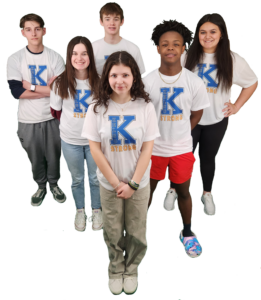Blue and gold posters throughout the Kelso School District feature a bold 100% and the silhouette of a student in a graduation gown. Everyone knows the message: To celebrate 100 years of blue and gold, we’re pursuing a 100% graduation rate. Kelso School Board members also are celebrating their recognition as WSSDA’s 2023 Board of the Year, Medium District.
The “100” theme is evident throughout the goals and priorities of the Kelso School District, including:
- 100% graduation rate.
- 100% of graduates post-secondary enrolled in two-year or four-year college, military or trade/apprenticeship programs.
- Educational equity, ensuring every student has the opportunity to succeed.
- A focus on individual success; “Every Kelso student will …” is the opening line to three of the four district goals.
- A commitment to each and every learner reaching their unique greatness.
“As a school board, we’re accountable to make sure every single child has the opportunity to learn and to have success, and to have the opportunities that everyone has and that everyone desires,” said Jeane Conrad, Kelso School Board president.
Educational Equity Focuses on Individual Needs
Superintendent Mary Beth Tack said Kelso board members’ commitment to the mission of preparing every student for living, learning and achieving success in our changing world ensures the district remains focused on student achievement and equity.
Rather than speak about equity in general concepts, Kelso leaders specifically focus on “educational equity.” Educational equity happens when each learner receives what they need to achieve their educational goals and aspirations.
“’Equity’ is a complex word. ‘Educational equity’ makes our work clear,” Tack said.
By Kelso’s definition, educational equity is a combination of:
- Cultural compassion — knowing students’ cultural histories, contexts, family norms and values.
- Diversity — the range of human differences within a given setting or group, based on multiple factors.
- Equity — the outcome supported by access to opportunity and a culture of belonging. Equity happens when each learner’s barriers are identified and eliminated.
- Inclusion — valuing and empowering diverse learners, ensuring each one is able to participate in all endeavors with a sense of belonging and purpose.
To put the educational equity approach into motion, leaders created a “theory of action” plan. The action plan outlines how everyone within the district will use their role to ensure every learner receives what they need.

Samples from the theory of action plan include: the district office leading with equity-driven, evidence based practices; principals creating a culture of collaboration and culturally responsive decisions; instructional staff elevating each student’s voice; and students actively engaging in their learning.
Goals Pave the Way to 100%
Kelso School Board members helped create four main focus areas for the district’s goals: school climate, early learning, quality instruction, and career, college and community readiness.
Fiscal responsibility also is on the roadmap to a 100% graduation rate. Clear implementation measures and their impacts outline how the district will strive to meet its financial goals of fiscal transparency and effective resource allocation.
“The board’s feedback and insight are invaluable in making informed decisions. They set clear goals and approve budgets that reflect and support our priorities,” Tack said. “Their advocacy and community engagement efforts amplify our work, helping to build trust and support for our initiatives.”
Tack has worked in the district for 33 years and was named superintendent in 2018. She said her mentors emphasized the importance of having strong relationships with board members because they set the tone for the rest of the district.
“Those relationships take time. It’s intentional work. You have to make sure it’s a priority,” she said.
Listening is a Board Priority
Knowing what staff and students need requires Kelso board members to do a lot of listening.
Three times each year, two board members conduct Cabinet Visits with administrators and staff at each school. They discuss progress toward their School Improvement Plans, and board members ask about on-site successes and concerns.
One to two board members pose similar questions to students during Listening Tour lunches at each school in the district.
“Students often identify a problem and come with a solution,” board president Conrad said. She recently heard a suggestion she liked so much that she volunteered to accompany the student to present the idea to the mayor.
Conrad also was impressed by one student who prepared for the lunch by asking his friends the pre-announced questions so he could bring their insights to the discussion.
“Everybody needs affirmation and knowing they are cared about,” she said.
Caring and trust are shared values among school board members. They ask a lot of questions and have a singular focus on what’s best for the students, Conrad said. They are trusting and transparent with each other.
“As board members, you have to be a unified team. Be a listening ear to the community and the kids. Make people feel valued,” she said.
Work sessions at each board meeting offer time to listen and learn about program updates and discuss topics within the strategic plan.
Board members attend WSSDA state and regional trainings for their own professional development.
In addition, Superintendent Tack created a guidebook to help new board members transition into their roles. Conrad noted that the guidebook has been a useful reference for all board members.
Family and Community Resource Center
Supporting each and every student includes what’s happening in their lives off campus. Kelso leaders explored ways to address students’ needs for clothing, school supplies and a place to stay — about 11% of students didn’t have permanent housing.
With community partners, the district opened the Family and Community Resource Center (FCRC). The program helps students and families in three primary areas: behavioral health, physical health and basic needs. Since it opened in 2021, FCRC has been especially focused on supporting families with their needs for housing, employment, food, school supplies, health and other services.
Kelso’s FCRC helped 47 families find stable housing in the 2022-23 school year. This allowed 58 school-age children to stay enrolled in Kelso schools.
“They have a home to go to every night, just like everyone else,” Conrad said. “When they come to school, they’re ready to go, to pass their tests, to dream big dreams because they know they can do it.”
FCRC staff are well versed in the federal McKinney-Vento Homeless Assistance Act, which ensures youth who are in between housing can fully participate in school. With stable housing and other support, Kelso’s McKinney-Vento students had a 93% graduation rate or higher in the last three consecutive years.
School Board has a Heart for Students, Staff
Through their support for FCRC and other activities, Kelso School Board members are helping to remove barriers for each student.
“I love being part of a team doing great work for the next generation,” Tack said. “It’s rewarding, and I’m still excited to come to work every day.”
Tack acknowledged that she has an incredible team, from every staff member to the school board. The WSSDA Board of the Year award affirms their great work.
“We have a long legacy of people stepping up to be on the school board. They have student- and staff-centered hearts and are an inspiration for the community.”
About this Article
This story originally appeared in the Summer/Fall 2024 issue of WSSDA Direct. See more great stories and all the latest issues at wssda.org/Direct.

